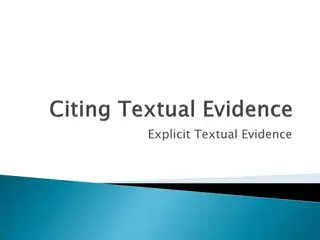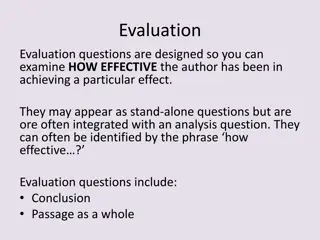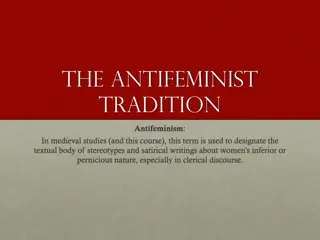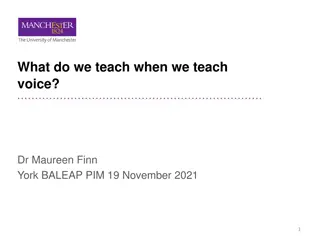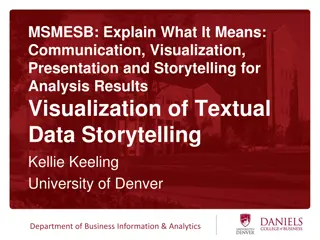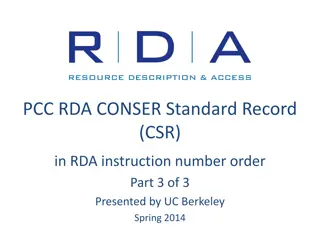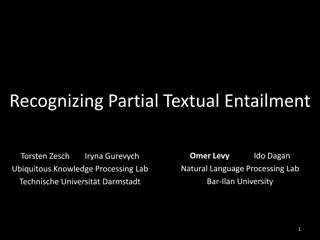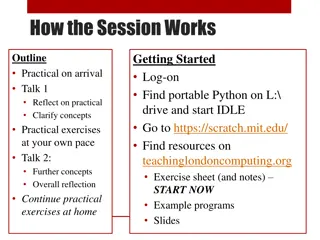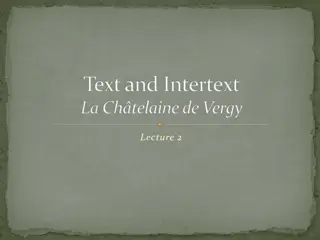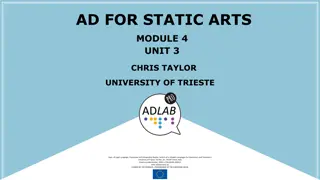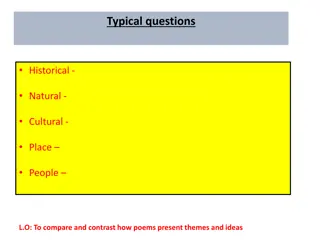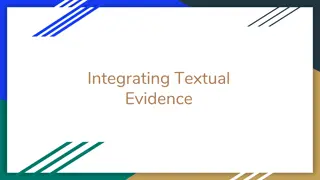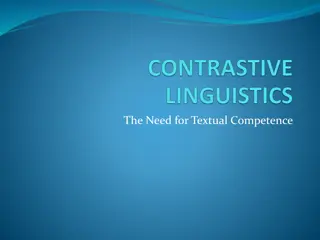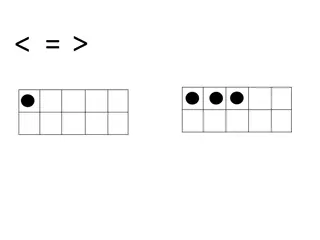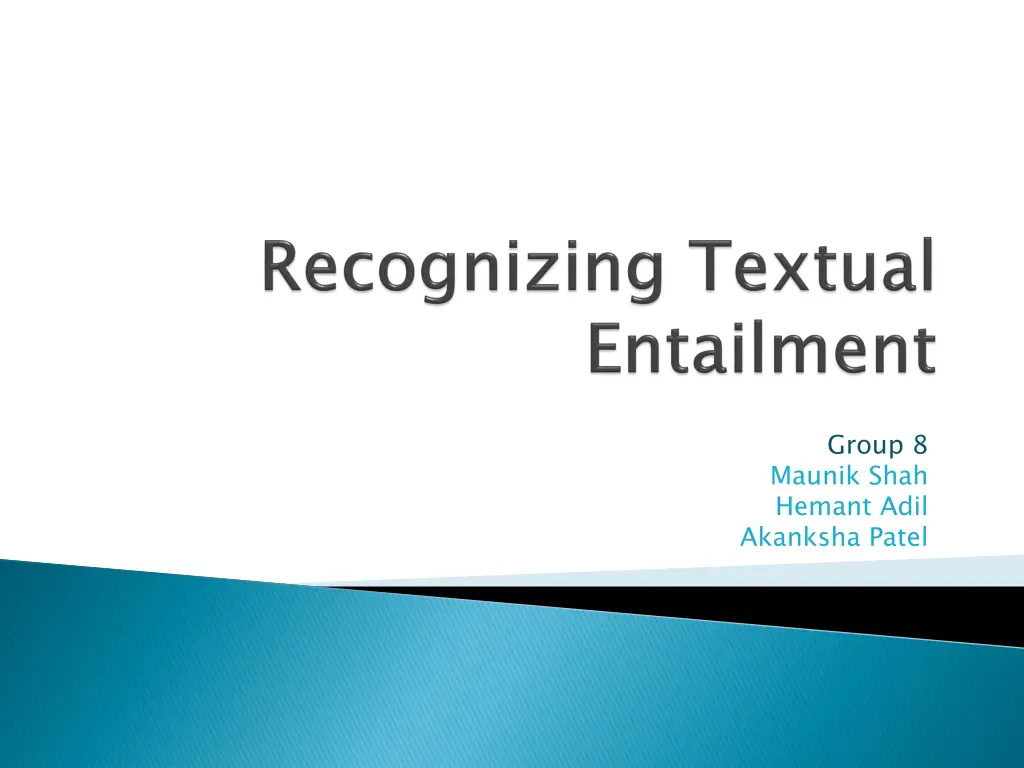
Understanding Textual Entailment in Natural Language Processing
Explore the concept of textual entailment where one text can be inferred to be true based on another, delving into the motivation, basic processes, challenges, and applications in NLP. Learn about the probabilistic nature of entailment, the importance of knowledge and text in validation, and how textual entailment can provide a common framework for semantic inference in text applications.
Download Presentation

Please find below an Image/Link to download the presentation.
The content on the website is provided AS IS for your information and personal use only. It may not be sold, licensed, or shared on other websites without obtaining consent from the author. If you encounter any issues during the download, it is possible that the publisher has removed the file from their server.
You are allowed to download the files provided on this website for personal or commercial use, subject to the condition that they are used lawfully. All files are the property of their respective owners.
The content on the website is provided AS IS for your information and personal use only. It may not be sold, licensed, or shared on other websites without obtaining consent from the author.
E N D
Presentation Transcript
Group 8 Maunik Shah Hemant Adil Akanksha Patel
John Smith spent six years in jail for his role in a number of violent armed robberies. John Smith spent six years in jail for his role in a number of violent armed robberies. Given Given John Smith was charged with two or more violent crimes. Is it true?
Given a text fragment is true, can we predict the truth value of another text fragment? This relationship among texts is textual entailment.
What is Textual Entailment Motivation Basic Process of RTE PASCAL RTE Challenges RTE Approaches ML based approach Applications Conclusions
A text hypothesis (h) is said to entail a text (t) if, a human reading t would infer that h is most likely true. [1] h entails y represented as h=>y
t probabilistically entails h if: P(h is true | t) > P(h is true) t increases the likelihood of h being true P(h is true | t ): entailment confidence From: Textual Entailment, Ido Dagan, Dan Roth, Fabio Zanzotto, ACL 2007
For textual entailment to hold we require: text AND knowledge h but knowledge should not entail h alone Systems are not supposed to validate h s truth regardless of t (e.g. by searching h on the web) From: Textual Entailment, Ido Dagan, Dan Roth, Fabio Zanzotto, ACL 2007
Text applications require semantic inference A common framework for applied semantics is needed, but still missing Textual entailment may provide such framework Motivation From: Textual Entailment, Ido Dagan, Dan Roth, Fabio Zanzotto, ACL 2007
Variability of semantic Expression Same meaning can be inferred from different texts. Ambiguity in meaning of words Different meanings can be inferred from same text Motivation Need of common solution for modeling language variability in NLP tasks Recognizing Textual Entailment
Two main underlying problems: Paraphrasing Strict Entailment
Paraphrasing: The hypothesis h h carries a fact fh is expressed with different words. fh that is also in the target text t t but the cat devours the mouse" is a paraphrase of "the cat consumes the mouse"
Strict entailment: Target sentences carry different fact, but one can be inferred from the other. There is strict entailment between the cat devours the mouse" the cat eats the mouse"
Entails Subsumed by Eyeing the huge market Eyeing the huge market potential, currently led by potential, currently led by Google, Yahoo took over Google, Yahoo took over search company search company Overture Services Inc. last Overture Services Inc. last year year Phrasal verb paraphrasing Phrasal verb paraphrasing Yahoo acquired Overture Yahoo acquired Overture Overture is a search company Overture is a search company Google is a search company Google is a search company Google owns Overture Google owns Overture . . Entity matching Entity matching Alignment Alignment Semantic Role Labeling Semantic Role Labeling Integration Integration From: Textual Entailment, Ido Dagan, Dan Roth, Fabio Zanzotto, ACL 2007
[ Goal ] to provide opportunity for presenting and comparing possible approaches for modeling textual entailment.
Text Hypothesis L Development Set Set Test Set
Text Hypothesis L Development Set Test Set Participating System
Text Hypothesis L Development Set Test Set Participating System
Text Hypothesis L Development Set Test Set Participating System Compare to determine efficiency of system
Main Task Recognizing Entailment 2 way entailment Best Accuracy : 70% Average Accuracy: 50 to 60%
Main Task Recognizing Entailment (on more realistic examples from real systems) 2 way entailment Best Accuracy : 75% Improvement in accuracy as compared to RTE1
Main Task Recognizing Entailment Pilot Task Extending Evaluation of Inference Text 2 way entailment Best Accuracy : Main task:80% Pilot Task:73% Improvement in accuracy as compared to RTE1 and RTE2
Main Task Recognizing Entailment (Development Set not given before-hand) 2 way and 3 way entailment Best Accuracy : 2 way entailment: 74.6% 3 way entailment: 68.5% Reduction in accuracy as compared to previous campaigns
Main Task Recognizing Entailment (length of text increased) Pilot Task: solving TE in summarization and Knowledge Base Population (KBP) Validation Best Accuracy : Main Task: 2 way entailment: 68.3% 3 way entailment: 73.5% Pilot Task: Precision=0.4098,Recall=0.5138, F-measure=0.4559 Reduction in accuracy, most probably due to increased length of text as compared to previous challenges
Main task: Text Entailment in Corpus Main Subtask: Novelty Detection Pilot Task: Knowledge Base Population (KBP) Validation Best Accuracy : Main Task: F-measure=0.4801 Main Subtask: F-measure=0.8291 Pilot Task: Generic RTE System: F-measure=0.2550 Tailored RTE System: F-measure=0.3307 Improvement in accuracy as compared to RTE 5 KBP task proved to be very challenging due to difference in Development and Test sets
Main task: Text Entailment in Corpus Subtask: Novelty Detection and Knowledge Base Population (KBP) Validation Best Accuracy : Main Task: F-measure=0.4800 Sub Task: Novelty Detection: F-measure=0.9095 KBP Validation: Generic RTE System: F-measure=0.1902 Tailored RTE System: F-measure=0.1834 Improvement in accuracy for Text Entailment in corpus and Novelty Detection. Reduction in performance of KBP task, shows most RTE systems are not robust enough to process large data.
Meaning Representation Meaning Representation Inference Logical Forms Semantic Representation Representation Syntactic Parse Local Lexical Raw Text Raw Text Text Entailment From: Textual Entailment, Ido Dagan, Dan Roth, Fabio Zanzotto, ACL 2007
Lexical only Tree similarity Predicate-argument structures Logical form - BLUE (Boeing) cross-pair similarity Learning alignment Alignment-based + Logic
Text :: Everybody loves somebody. Hypothesis :: Somebody loves somebody. Predicate :: Love(x,y) = x Loves y Text :: x y Love (x,y) Hypothesis :: x y Love (x,y) Here Text =>> Hypothesis... So we can say that hypothesis is entailed by Text
T :: I can lift an elephant with one hand H1 :: I can lift very heavy thing. H2 :: There exist an elephant with one hand. Needs support of parsing and tree structure for finding correct entailment. Knowledge is the key to solve text entailment.
Support also needed from WSD (Word Sense Disambiguation) NER (Name Entity Recognition) SRL (Statistical Relationship Learning) Parsing Common background Knowledge
Intuition says that entailment pairs can be solved, in the majority of cases, by examining two types of information, 1) The relation of the verbs in the hypothesis to the ones in the text 2) Each argument or adjunct is an entity, with a set of defined properties
Levins classes Levin s classes VerbNet VerbNet A Predication and argument Based Algorithm A Predication and argument Based Algorithm
The largest and most widely used classification of English verbs over 3,000 English verbs according to shared meaning and behavior. Intuition: a verb's meaning influences its syntactic behavior shows how identifying verbs with similar syntactic behavior distinguishing semantically coherent verb classes, and isolates these classes by examining verb behavior with respect to a wide range of syntactic alternations that reflect verb provides an effective means of
online verb lexicon for English that provides detailed syntactic and semantic descriptions for Levin taxonomy. hierarchical, coverage verb lexicon. has mappings to a number of widely used verb resources, such as FrameNet and WordNet. Example of VerbNet VerbNet Class eat-39.1 is given next... Levin classes classes organized into a refined domain-independent, broad-
VerbNet <FRAME><DESCRIPTION descriptionNumber="" primary="NP V NP ADJ" secondary="NP-ADJPResultative" xtag=""/><EXAMPLES><EXAMPLE>Cynthia ate herself sick.</EXAMPLE></EXAMPLES><SYNTAX><NP value="Agent"><SYNRESTRS/></NP><VERB/><NP value="Oblique"><SELRESTRS><SELRESTR Value="+" type="refl"/></SELRESTRS></NP><ADJ/></SYNTAX><SEMANT ICS><PRED value="take_in"><ARGS><ARG type="Event" value="during(E)"/><ARG type="ThemRole" value="Agent"/><ARG type="ThemRole" value="?Patient"/></ARGS></PRED><PRED value="Pred"><ARGS><ARG type="Event" value="result(E)"/><ARG type="ThemRole" value="Oblique"/></ARGS></PRED></SEMANTICS></FRAME> VerbNet Class eat Class eat- -39.1 39.1
Step 1:: Text (T) and Hypothesis(H) and attach the appropriate semantic description, on the basis of the Levin class and syntactic analysis. Extract the Levin class for all the verbs in
Step 2:: Same levin Text Hypothesis Has verb q has verb p
Arguments and adjuncts match, verbs not opposite Example Step 2 A) T: The cat ate a mouse H: Mouse is eaten by a cat Entailment Verb match but arguments and adjuncts opposite Step 2 B) T: The cat ate a large mouse. H: The cat ate a small mouse. Contradiction Step 2 C) T: The cat ate a mouse. H: The cat ate in the garden. Unrelated Arguments not related
Step 2 A) For all candidates p in T, if the arguments and adjuncts match over p and q, and the verbs are not semantic opposites (e.g. antonyms or negations of one another), return ENTAILMENT B) Else, (i) if the verbs match, but the arguments and adjuncts are semantic opposites (e.g. antonyms or negations of one another), or the arguments are related but do not match return CONTRADICTION (ii) else if the arguments are not related, return UNKNOWN C) Else, return UNKNOWN
Step 3: Not Same levin Text Hypothesis Has verb q has verb p Obtain relation from p to q based on Levin semantic description q is semantically opposite to p and arguments match> Contradiction Arguments not match> Unknown Verbs not opposite and arguments match > Entailment Verbs not related> Unknown
Step 3 :: For every verb q in H, if there is no verb p in T has the same Levin as q, extract relations between q and p on the basis of Levin semantic descriptions A) If the verbs in H are not semantic opposites (e.g. antonyms or negations of one another)of verbs in T, and the arguments match, return ENTAILMENT B) Else, (i) if q is semantically opposite to p and the arguments match, or the arguments do not match, return CONTRADICTION (ii) else if the arguments are not related, return UNKNOWN C) Else, return UNKNOWN Step 4 :: Return UNKNOWN
Intuition of this algorithm is taken from structure of VerbNet which has subset meanings like: give and receive declared and proclaimed gain and benefit or synonyms and antonyms and so on.. verb inference like: hungry then eat thirsty then drink tired then rest
Example 1: Exact match over VN classes T: MADAGASCAR'S constitutional court declared Andry Rajoelina as the new president of the vast Indian Ocean island today, a day after his arch rival was swept from office by the army. ... H: Andry Rajoelina was proclaimed president of Madagascar. . Match in terms of verb [Step 3] (can be verified using VN and Levin classes) Requirement of backgroud knowledge
Example 2: Syntactic description and semantic decomposition T: A court in Venezuela has jailed nine former police officers for their role in the deaths of 19 people during demonstrations in 2002. ... H: Nine police officers have had a role in the death of 19 people. Predicate can be written as P(theme 1, theme 2)
The results have shown that such an approach solves 38% of the entailment pairs taken into consideration; also, a further 29.5% of the pairs are solved by the use of argument structure matching. Even verbs are not attached or one of the key concepts in H is not even existed in T, this method can solve them because of argument structure matching.
RTE task can be thought as classification task. Whether hypothesis entails a text or not Yes Text Feature extractio n Classi fier Hypothesis No
We have off the shelf classifier tools available. We just need features as input to classifier . Possible Features : Distance features Entailment Triggers Pair Feature
Numbers of words in common Length of Longest common subsequence Example T: All I eat is mangoes. H: I eat mangoes. No. of common words = 3 length of lcs = 3
Polarity features Presence /absence of negative polarity contexts (not , no or few without) Antonym features Presence/absence of antonymous word in T and H Dark knight rises => Dark knight doesn t fall Dark knight is falling Dark knight is rising Adjunct features Dropping/adding of syntactic adjunct when moving from T to H He is running fast => He is running


